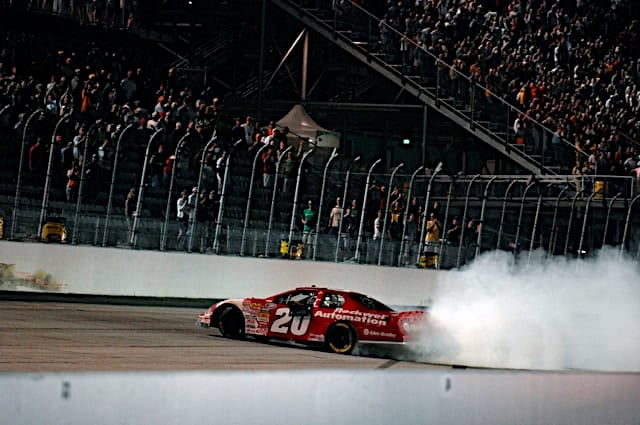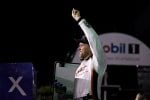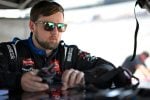This past Friday (Aug. 22) at Daytona International Speedway, NASCAR fans were treated to a feel-good story when Parker Kligerman won the NASCAR Xfinity Series race.
Kligerman had never won in the series before, though he missed out by a couple of feet at the Charlotte Motor Speedway ROVAL last year when a late caution changed the complexion of the day.
Thanks to the NASCAR rulebook, he still hasn’t officially won in the Xfinity Series.
Kligerman was driving in relief of JR Motorsports driver Connor Zilisch, who had surgery on his broken clavicle. Under NASCAR rules, the driver who starts the race is credited with the finish in both the record book and the point standings. It was designed to help protect an injured driver before playoff waivers and the points reset allowed them to miss a race without major consequences, though it certainly also helped Zilisch in 2025.
Enter Kligerman. At age 35, he’s more of a journeyman than a fixture in any series. He made his first national start in the Xfinity Series at Kansas Speedway in 2009 at 19 years old and promptly won the pole racing for Team Penske, but full-time rides were hard to come by. Kligerman has had just three full seasons in Xfinity and a couple in the Craftsman Truck Series to go with a lot of years as a part-timer.
He’s a TV pit reporter when he’s not racing and has become a fan favorite as a driver and broadcaster thanks to his genuine personality and knowledge of the sport.
Saturday night, all his childhood dreams came true when he took the checkers, driving for his childhood hero Dale Earnhardt Jr. Kligerman celebrated like a winner and was treated like one by the team in victory lane, including Zilisch, who had watched from the pits after getting out of the car. The youngster was the first to greet Kligerman after the race.
Kligerman’s win-that-wasn’t was a hugely popular one, with fans in both his corner and that of the injured Zilisch. Not only was Kligerman helping out a popular youngster, but as a driver, he’d been an underdog for most of his career.
Everybody loves an underdog.
And because of that, that race is a perfect example of how history can be colored by circumstances and by who is behind the wheel. Friday night was the ultimate feel-good story for many fans. But a race that had a similar outcome in 2007 had the exact opposite effect.
There was no love for the relief driver that night.
The Xfinity Series was visiting the Milwaukee Mile for a standalone weekend with the Truck Series while the NASCAR Cup Series was on the West Coast at Sonoma Raceway.
Joe Gibbs Racing Cup driver Denny Hamlin was scheduled to run both races, with JGR’s part-time NXS driver Aric Almirola set to practice and qualify the No. 20 NXS car while Hamlin was at Sonoma for his Cup duties. Hamlin would fly to Milwaukee and start the race from the rear. Sponsor Rockwell Automation was based in Milwaukee and had many of its employees on hand to see Hamlin race.
Except Hamlin was running late. As race time rapidly approached, Hamlin was on his way to the track by helicopter from the airport, but the helipad wasn’t available, so the chopper couldn’t land.
Finally, NASCAR forced the team’s hand, and Almirola was tagged to start the race.
He had already qualified on the pole, edging out Jason Leffler and hometown favorite Scott Wimmer.
Almirola was a relative unknown at the time, having run the Truck Series in 2006 with three top 10s for owner Wayne Spears and finishing 18th in driver points. He ran 18 Xfinity Series races for JGR in 2007 including the Milwaukee start.
Because he had qualified the car, Almirola didn’t have to drop to the rear when the AT&T 250 rolled off. When the green flag dropped, Almirola made the most of his second pole of the season, leading the opening laps handily with fans cheering him on.
On lap 29, oil from the expired engine of Ian Henderson, who was making his first and only national series start for Means Racing, slicked the track and forced a caution. Almirola lost the lead to Carl Edwards, who had made it from Sonoma in time, on the restart, and that was enough for the Rockwell folks who were there to see Hamlin race.
When the third caution of the night flew on lap 57 for a Ron Hornaday Jr. spin, Hamlin was waiting on pit road and jumped into the car under the yellow flag. He lost a lap, which he would get back thanks to a free pass later in the night.
Hamlin’s drive to the front was impressive in its own right. He led twice in the final 100 laps for a total of 64, including the last one. He beat Wimmer by half a second for what would have been his second win of the year if Almirola didn’t get the credit.
It was not a popular outcome.
Many fans thought Almirola had more than earned the chance to finish the race he had qualified on the pole for and dominated early. JGR and Rockwell took a lot of heat for pulling Almirola, a young, developing driver, for Hamlin, who was already an established Cup driver in his second season, having finished his rookie season third in points. Fans thought Almirola had been given the shaft, and they were convinced that he should have been allowed to finish the race.
But while Hamlin has his share of detractors among race fans, at the time he wasn’t the main reason fans were unhappy with the driver swap. If he had been a full-time Xfinity Series driver at the time making the odd Cup start instead of the other way around, fans might not even feel the same way about how it turned out.
But at that point in NASCAR history, there was more to it.
At the time, there were no limits on the number of races that Cup regulars could run in the Xfinity and Truck series. Because the Xfinity Series was still the Busch Series at the time, drivers who stepped down from the Cup Series to cherry-pick trophies got pegged as “Buschwhackers” by fans who didn’t like that they were competing with Cup-level support from teams and sponsors.
By the time the Xfinity teams rolled into Milwaukee in late June of 2007, there were 16 races on the books. Of those 16, exactly one — the previous week at Kentucky Speedway — had been won by a series regular, Stephen Leicht, in his only career victory.
The other 15?
All Cup regulars, starting with Kevin Harvick at Daytona International Speedway in February. From there, it read like a Cup Series who’s who: Matt Kenseth (with two wins in that span), Juan Pablo Montoya (one win), Jeff Burton (two), Edwards (four), Clint Bowyer (two) and one each for Bobby Labonte, Hamlin and Kasey Kahne. Though he would become the face of the Buschwhackers, Kyle Busch hadn’t won yet in that season, though he would a couple weeks later.
Entering the weekend at Milwaukee, Hamlin was sitting second in Cup driver points.
All told in 2007, Cup regulars won 30 of 35 Xfinity races, and that’s counting Almirola as the winner of record at Milwaukee.
And the title? Drivers could race for points in all three national series at the time, and Xfinity and Trucks still had a full-season championship under the Latford points system. Running all 35 races in Xfinity, Edwards ran away with the title by over 600 points over Leffler. Harvick finished fourth despite running only 26 races (and winning six), and David Ragan, who was in his rookie season in Cup, was fifth.
Fans were becoming increasingly frustrated with the situation, but it would be a few more years before NASCAR would limit drivers to racing for points in one series and later to the number of races Cup regulars could run in other series at all.
So, on a night where a development driver was performing admirably, race fans wanted to see him have the opportunity to try and win on his own. When the sponsor overruled them, the frustration with the Cup driver takeover in the series boiled over.
So, while the outcomes of two races nearly two decades apart were similar, the circumstances around them were completely different. One takeover winner was a fan favorite despite the rulebook not recognizing him. The other became the villain of the story despite the call not being up to him.
In this case, the rule and NASCAR’s application of it were unchanged and consistent. But the players and the circumstances made the two situations vastly different even while the history books treat them the same.
Amy is an 20-year veteran NASCAR writer and a six-time National Motorsports Press Association (NMPA) writing award winner, including first place awards for both columns and race coverage. As well as serving as Photo Editor, Amy writes The Big 6 (Mondays) after every NASCAR Cup Series race. She can also be found working on her bi-weekly columns Holding A Pretty Wheel (Tuesdays) and Only Yesterday (Wednesdays). A New Hampshire native whose heart is in North Carolina, Amy’s work credits have extended everywhere from driver Kenny Wallace’s website to Athlon Sports. She can also be heard weekly as a panelist on the Hard Left Turn podcast that can be found on AccessWDUN.com's Around the Track page.





